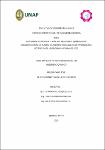| dc.contributor.advisor | Ruiz Vásquez, Liliana | |
| dc.contributor.advisor | Ruiz Mesia, Lastenia | |
| dc.contributor.advisor | Ruiz Mesia, Wilfredo | |
| dc.contributor.author | Caballero Ceferino, Henrry Denny | |
| dc.date.accessioned | 2022-03-10T18:14:24Z | |
| dc.date.available | 2022-03-10T18:14:24Z | |
| dc.date.issued | 2022 | |
| dc.identifier.uri | https://hdl.handle.net/20.500.12737/7868 | |
| dc.description.abstract | The annual application of herbicides in the world increases every year, due to the great losses of crops due to weeds, as an alternative to this, we have the use of agrochemicals, especially herbicides, which may be the only effective way to temporarily defend a weed crop. However, nowadays, dangerous herbicides are applied in the fields, causing harm to farmers, consumers and the environment. Due to this, the search for new alternatives is proposed, such as the identification of natural substances with allelopathic effects to obtain natural herbicides. Essential oils are a suitable type of allelochemicals to be used as bioherbicides due to their biodegradability, high structural diversity, and natural resistance to reducing weeds.
The objective of this research is to search for phytotoxic potentials from the essential oils of plant species of the Piparaceae family. For the extraction of the ten (10) essential oils, the hydrodistillation method was used, the species are: P. coruscan Kunth, P. sancti-felicis trel, P. casapiense (Miq) C. DC, P. obliquum Ruiz & Pav, P. anonifolium (Kunth), P. tuberculatum Jacq, P. dumosum Rudge, P. reticulatum L, P. soledadense Trel y P. mituense Trel & Yunck. Essential oils were tested against the monocot Lolium perenne L. and the dicot Lactuca sativa F. As a result, it was observed that all Piper essential oils were active against L. perenne L, while only the essential oils of P. sancti-felicis trel, P. mituense Trel & Yunck, P. reticulatum L and P. casapiense (Miq) C. DC. were active against L. sativa F.
In the analysis by gas chromatography pinned to masses of the essential oils that presented the best results of phytotoxic activity against L. perenne L and L. sativa F, were P. sancti-felicis (76,08%), P. mituense (51, 58%), P. reticulatum (14,99%), which have the phenylpropanoid apiol as the main compound and P. casapiense (22,64%) to the bicyclic compound [5,2,0] nonane, 2-methylene-4, 8,8-trimethyl-4-vinyl. | en_US |
| dc.description.abstract | La aplicación anual de herbicidas en el mundo aumenta cada año, debido a que hay grandes pérdidas de los cultivos a causa de las malezas, como alternativa a esto tenemos el uso de agroquímicos, especialmente herbicidas, que pueden constituir la única manera eficaz de defender temporalmente un cultivo de las malas hierbas. Sin embargo, hoy en día, se aplican herbicidas peligrosos en los campos, causando daños a los agricultores, los consumidores y el medio ambiente. Debido a esto se propone la búsqueda de nuevas alternativas, como la identificación de sustancias naturales con efectos alelopáticos para la obtención de herbicidas naturales. Los aceites esenciales son una clase adecuada de aleloquímicos para ser utilizados como bioherbicidas debido a su biodegradabilidad, alta diversidad estructural y resistencia natural reduciendo las malas hierbas.
El objetivo de este trabajo de investigación es la búsqueda de potenciales fitotóxicos a partir de los aceites esenciales de especies vegetales de la familia Piparaceae. Para la extracción de los diez (10) aceites esenciales se utilizó el método de hidrodestilación, las especies son: P. coruscan Kunth, P. sancti-felicis trel, P. casapiense (Miq) C. DC, P. obliquum Ruiz & Pav, P. anonifolium (Kunth), P. tuberculatum Jacq, P. dumosum Rudge, P. reticulatum L, P. soledadense Trel y P. mituense Trel & Yunck. Los aceites esenciales fueron ensayados frente a la monocotiledónea Lolium perenne L. y la dicotiledónea Lactuca sativa F. Como resultado se observó que todos los aceites esenciales de Piper, fueron activos frente a L. perenne L, mientras que solo los aceites esenciales de P. sancti-felicis trel, P. mituense Trel & Yunck, P. reticulatum L y P. casapiense (Miq) C. DC, fueron activos frente a L. sativa F.
En el análisis por cromatografía de gases acoplada a masas de los aceites esenciales que presentaron los mejores resultados de actividad fitotóxica frente L. perenne L. y L. sativa F, fueron P. sancti-felicis Trel (76,08%), P. mituense Trel & Yunck (51,58%), P. reticulatum L (14,99%), que tienen como compuesto mayoritario al fenilpropanoide apiol y P. casapiense (22,64%) al compuesto biciclo[5,2,0]nonane, 2-metileno-4,8,8-trimetil-4-vinil. | es_PE |
| dc.format | application/pdf | es_PE |
| dc.language.iso | spa | es_PE |
| dc.publisher | Universidad Nacional de la Amazonía Peruana | es_PE |
| dc.rights | info:eu-repo/semantics/openAccess | * |
| dc.rights.uri | https://creativecommons.org/licenses/by/4.0/ | * |
| dc.subject | Fitoquímica | es_PE |
| dc.subject | Análisis químico | es_PE |
| dc.subject | Aceites esenciales | es_PE |
| dc.subject | Piperaceae | es_PE |
| dc.subject | Herbicidas | es_PE |
| dc.title | Actividad fititóxica y análisis del perfil químico por cromatografía de gases de aceites esenciales de piperáceaes potenciales herbicidas naturales 2020 | es_PE |
| dc.type | info:eu-repo/semantics/bachelorThesis | es_PE |
| thesis.degree.discipline | Ingeniería Química | es_PE |
| thesis.degree.grantor | Universidad Nacional de la Amazonía Peruana. Facultad de Ingeniería Química | es_PE |
| thesis.degree.name | Ingeniero(a) Químico(a) | es_PE |
| dc.subject.ocde | http://purl.org/pe-repo/ocde/ford#2.04.01 | es_PE |
| renati.author.dni | 47214056 | |
| renati.advisor.orcid | https://orcid.org/0000-0001-9042-7240 | |
| renati.advisor.orcid | https://orcid.org/0000-0002-9385-5416 | |
| renati.advisor.orcid | https://orcid.org/0000-0002-4241-0978 | |
| renati.advisor.dni | 40853706 | |
| renati.advisor.dni | 05274098 | |
| renati.advisor.dni | 05394098 | |
| renati.type | http://purl.org/pe-repo/renati/type#tesis | es_PE |
| renati.discipline | 531026 | es_PE |
| renati.level | http://purl.org/pe-repo/renati/level#tituloProfesional | es_PE |
| renati.juror | Ríos Ríos, Jorge Manases | |
| renati.juror | Suárez Rumiche, Jorge Antonio | |
| renati.juror | León Vargas, Frank Romel | |
| dc.publisher.country | PE | es_PE |


